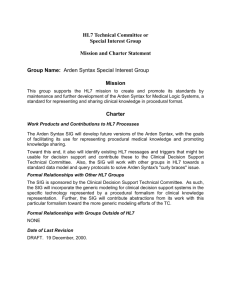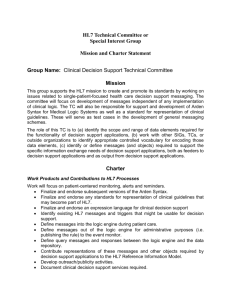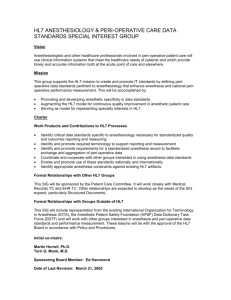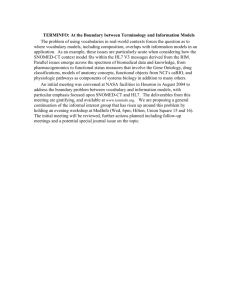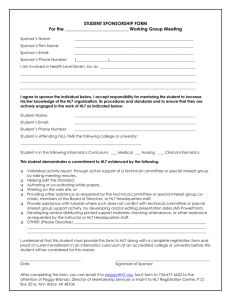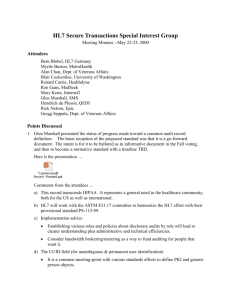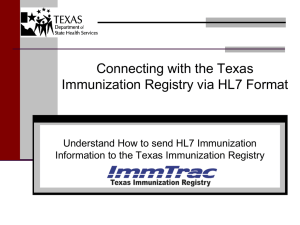vocsigjan98
advertisement
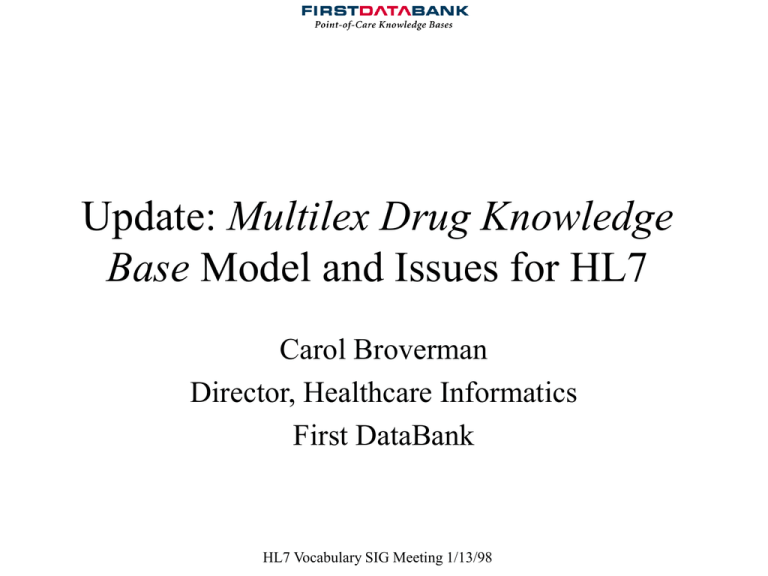
Update: Multilex Drug Knowledge Base Model and Issues for HL7 Carol Broverman Director, Healthcare Informatics First DataBank HL7 Vocabulary SIG Meeting 1/13/98 Outline • What are we trying to do? • What should a drug data model provide and to whom? • Quick review of the Multilex DKB from 30K FT • Clarifications to model vis-à-vis vocabulary • Identify needs in HL7 2.3 messages • Identify related entities/attributes in V3.0 RIM • Issues we see with Multilex DKB and V3.0 RIM HL7 Vocabulary SIG Meeting 1/13/98 Focusing on the Need at Hand • What are we really trying to achieve? – Agree on a vocabulary to support the exchange (and subsequent use) of information and transactions related to drugs • How much detail of the models need to be exposed and why? – Expose what is necessary only to evaluate how resulting vocabulary supports HL7 messaging needs, and provide hooks to applications that will send, receive, share and use information in HL7 messages. HL7 Vocabulary SIG Meeting 1/13/98 What Does HL7 Need from a Drug Vocabulary? • • • • Drug concepts and meanings: sound semantic basis Codes for concepts that are “principled” Terms for codes that offer synonymy “Different strokes for different folks:” concepts/codes/terms at different abstraction levels to support a range of HL7 messaging needs and range of stakeholders • Internationalization support • Versioning support and assurance of maintenance HL7 Vocabulary SIG Meeting 1/13/98 HL7 Needs (continued) • HL7 is middleware: vocabulary provides hooks to applications who are doing the “real work” • Receiving and sending applications decode and use internally when they HL7 messages with a drug knowledge base of their choice – e.g., Decision support is a demanding application/user • So… the “external” vocabulary must be based on well-defined internal codes and concepts – ingredient codes, therapeutic classification codes, relationships, etc…. HL7 Vocabulary SIG Meeting 1/13/98 Drug Product Variations Representable in the Multilex DKB Data Model multiple drugs, non-concurrent administration multiple dose forms and routes multiple dose forms, concurrent administration Packaged Drug Product Manufactured Drug Manufactured Drug Component Clinical Drug HL7 Vocabulary SIG Meeting 1/13/98 single drug, branded product single drug, nonbranded product Packaged Drug Product Manufactured Drug Clinical Drug Generic Ingredient Set Ingredient: a chemical or biological component of a drug. Ingredient Comparable NDDF concept: HIC Generic ingredient set: the set of one or more therapeutically active ingredients present in a drug. Comparable NDDF concept: HICL Clinical drug: a set of strength-specific therapeutically active ingredients intended in any single clinical circumstance for concurrent administration by one of a set of appropriate potential routes in a specific dose form. Comparable NDDF concept: GCN-SEQNO Manufactured drug: one or more components which together are intended for concurrent administration. Each component is a specific clinical drug produced by a specific manufacturer. A Manufactured Drug may also optionally include an associated drug device. Most Manufactured Drugs are single-component. Comparable NDDF concept: Core-9 NDC Packaged drug product: a marketed drug product as it is packaged by a specific manufacturer and sold in a specific country; contains one or more manufactured drugs. Comparable NDDF concept: NDC HL7 Vocabulary SIG Meeting 1/13/98 Which Levels Matter Most for HL7? • Clinical drug (aka “generic formulation”) • Packaged drug product • Manufactured drug?? • Others: dose form, route, classification scheme codes • More on this later…. HL7 Vocabulary SIG Meeting 1/13/98 Clarifications (Multilex) HL7 Vocabulary SIG Meeting 1/13/98 Why does a Clinical Drug Specify a Set of Routes? • Clinical drug: a set of strength-specific therapeutically active ingredients intended in any single clinical situation for concurrent administration by one of a set of appropriate potential routes in a specific dose form. • A drug is a static entity. It is associated with a set of appropriate routes by which that drug may be administered when being used to treat a patient • The actual route is part of the order HL7 Vocabulary SIG Meeting 1/13/98 Multilex Route and Dose Form Representation: Why? • Routes are fully defined by a site of administration and a method of administration • Site and method are related and form an association -- route is a composite entity • Dose Form is related to route through the site of administration since they constrain each other • Similar (but not quite) to HL7 PtRoute – more on this later HL7 Vocabulary SIG Meeting 1/13/98 Clinical Drug Therapeutically Active Ingredient exists in Physical Dose Form represented in Dose Form Physical State applicable at Dose Form represented in Ingredient Route Set Dose Form exists in Generic Ingredient Set represented in a variation specified by Dose Form Site Qualification represents Route of Administration applicable to Dose Form Physical Modifier represents represented in Dose Form Physical Variation represented in Site of Administration HL7 Vocabulary SIG Meeting 1/13/98 Method of Administration Synonyms and Mappings (e.g.UMLS) • Each entity has 1+ entity descriptions attached • Country-language specific • Usage type and external mapping links to each entity description can indicate whether terms are used to: – record lexical synonymy – record usage preference synonymy – record mappings to UMLS (or other vocabulary identifiers) HL7 Vocabulary SIG Meeting 1/13/98 ENTITY DESCRIPTION ENTITY long description version EntityDescription: support terms, synonyms, user preferences, and cross-vocabulary mappings (e.g. UMLS) short description version other entity-specific descriptions Vocabulary terms: All entities have country/language/usagespecific entity descriptions. Language in Country for represented by Country for represented by Language HL7 Vocabulary SIG Meeting 1/13/98 Usage Type EXTERNAL MAPPING type version code_value Packaged Drug Product (France) Packaged Drug Description short description: “Valium ….” Product Id: CIP=3111289 long description: “Valium Roche comprime secable a 5mg, cpr E/40” Example : Diazepam 5MG Tablet, Oral Language in Country: for for General Usage French represented by Usage Type: represented by Country: Language: France French HL7 Vocabulary SIG Meeting 1/13/98 Packaged Drug Product (France) Packaged Drug Description short description: “Valium….” Product Id: CIP=3111289 long description: “Valium Roche comprime secable a 5mg, cpr E/40” Example : Diazepam 5MG Tablet, Oral Language in Country: for for French represented by represented by Country: Language: France French HL7 Vocabulary SIG Meeting 1/13/98 EXTERNAL MAPPING: type: UMLS version: 98 code_value: CUI_123 Full Presentation of Model • As presented to HL7 in August 1997 – http://www.mcis.duke.edu/standards/HL7/pubs/minutes/ 9708 --- download multilex.zip • Current Multilex DKB incorporating feedback thus far from customers and standards community – http://www.firstdatabank.com after this week – Carol_Broverman@firstdatabank.com HL7 Vocabulary SIG Meeting 1/13/98 Status of Multilex DKB • Currently building 4 international databases as Alpha Test: Belgium, Ireland, France, Germany • Sample U.S. test DKB delayed due to some redesign and resource limitations but will be on web site ~2Q98 • USA version, including Clinical Modules, slated for availability to limited set of customers late 1998 • Feedback still welcomed and solicited HL7 Vocabulary SIG Meeting 1/13/98 Explicit HL7 Needs • Clinical Drug (aka Generic Formulation) • Packaged Drug Product – Sometimes Manufactured Drug? • Dose Form • Route • Therapeutic classification codes, pharmaceutical classification codes needed for Master Tables HL7 Vocabulary SIG Meeting 1/13/98 Relevant 2.3 HL7 messages • ORC (Common order segment) may contain: – codes of interacting substances – levels of severity of interaction (should we tackle standardizing this vocabulary too?) • ORM (pharm tx order msg) – RXO (pharm tx segment) • requested_give_code (identify for drug…. Clinician level?) • requested_dispense_code (transformation of order) HL7 Vocabulary SIG Meeting 1/13/98 Relevant HL7 2.3 Messages • ORM (pharm tx order msg continued) – RXR (pharm tx route segment) • route + site + admin_device + admin_method • route (1st component) may imply the others, or may not… optionality may go away in 3.0 • We believe site and method are interrelated – RXC (pharm tx component order) • component_id for either base or additive HL7 Vocabulary SIG Meeting 1/13/98 HL7 2.3 Issues • RDE/RRE (pharm tx encoded order message) – comes from pharmacy – RXE segment (pharm tx encoded order segment) • this is at the package level: includes pkg size • RDS/RRD (pharm tx dispense msg) – Would be routed to nursing app -- already know what’s dispensed -- packaged product level – RXD (pharm tx dispense segment) • has lot number, pkg size, manufacturer – RXG (pharm tx give segment) -- also package attributes HL7 Vocabulary SIG Meeting 1/13/98 HL7 2.3 Issues • RAS/RRA (pharm tx administration msg) – msg created by nursing app and fed to order app or pharm -- data used to generate medication administration reports (MAR) • Summary: – More analysis to be done – Clear motivation for needing different levels of drug identification to support application and messaging needs HL7 Vocabulary SIG Meeting 1/13/98 Affected 3.0 RIM Objects • Master_service – – – – universal_service_id universal_service_identifier_coding_scheme_name universal_service_identifier_name procedure_medication_cd • Master_treatment_service – dea_level_cd – drug_category_cd – medication_form_cd (continued on next page) HL7 Vocabulary SIG Meeting 1/13/98 Affected RIM Objects (continued) • Master_treatment_service (continued) – Pharmaceutical_class_cd – route_cd – therapeutic_class_cd • Patient_service_order – service_body_site_cd – service_body_site_modifier_code – service_body_source_code (continued) HL7 Vocabulary SIG Meeting 1/13/98 Affected RIM Objects (continued) • Treatment_service_dispense – – – – – dispense_package_size_amount (not a code though) dispense_Ptcomp dispense Ptroute indication_cd (comes from other vocab source) substance_manufacturer_cd • continued….. HL7 Vocabulary SIG Meeting 1/13/98 Affected RIM Objects (continued) • Treatment_service_order – indication_cd (from other vocab) – requested_give_strength_amt (may be code or structured) • Treatment_service_order_revision – order_revision_Ptcomp – order_revision_Ptrout – ordered_administration_method_cd HL7 Vocabulary SIG Meeting 1/13/98 Issues for the 3.0 RIM • Identifiers for master_treatment_service id (drug) may be at different levels • HL7 PTRoute includes device….. Why? (mismatch) • Clarify pharmaceutical_class_cd, therapeutic_class_cd, and drug_category_code… ??? • Shouldn’t dose form and route(s) be interdependent • Dea_level_code is U.S. specific • Clarify Dispense_PtComp -- only base and additive? • Service_body_source_code versus service_body_site_code ?? HL7 Vocabulary SIG Meeting 1/13/98 UMLS Issues • From stated goals: “… meaning and use of drug codes and vocabulary as used in HL7 messages may be stated against concepts in the Metathesaurus” • This may not be possible with Clinical Drug (Generic Formulation) only since many messages and use cases are at the packaged level and these will not be in the UMLS. – Send CUI^<vendor_pkg_level_id>^<version>^term ?? HL7 Vocabulary SIG Meeting 1/13/98 Next Steps • Need feedback from Orders and Results to make sure we understand the issues/use cases and are in sync – Subgroup from vocabulary/medications and O&R • Need to work with RIM harmonization group – Subgroup from vocabulary/medications • Unify vendor perspectives – Reps from different vendors with VocabSIG oversight • Get in sync with other SDO’s needs -- NCPDP? HL7 Vocabulary SIG Meeting 1/13/98
